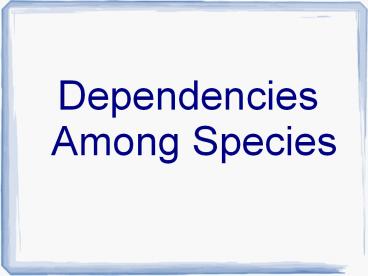Dependencies Among Species
1 / 8
Title:
Dependencies Among Species
Description:
Dependencies Among Species Dependencies Among Species Each species depends on the services provided by other species to ensure survival. It is a type of cooperation ... –
Number of Views:54
Avg rating:3.0/5.0
Title: Dependencies Among Species
1
- Dependencies Among Species
2
Dependencies Among Species
- Each species depends on the services provided by
other species to ensure survival. - It is a type of cooperation based on mutual
survival and is often what a balanced ecosystem
refers to. - Many relationships in nature involve dependence.
Sometimes species are so closely linked that the
survival of one depends completely on the
survival of another.
3
Dependencies Among Species
- Many people are familiar with species
relationships such as predation and parasitism,
but not all survival relationships are harmful. - Many species evolve in close contact that
gradually benefits both partners so much that
each species comes to rely on the other
completely for its continued survival.
4
Dependencies Among Species
- Plants provide food, shelter, and nesting sites
for other organisms. - For their part, many plants depend upon animals
for help in reproduction (bees pollinate flowers,
for instance) and for certain nutrients (such as
minerals in animal waste products). - All animals are part of food webs that include
plants and animals of other species (and
sometimes the same species). - The predator/prey relationship is common, with
its offensive tools for predatorsteeth, beaks,
claws, venom, etc.and its defensive tools for
preycamouflage to hide, speed to escape, spines
to ward off, irritating substances to repel. - Some species come to depend very closely on
others (for instance, pandas or koalas can eat
only certain species of trees). - Some species have become so adapted to each other
that neither could survive without the other (for
example, the wasps that nest only in figs and are
the only insect that can pollinate them).
5
Yucca Plants and Yucca Moths
- Sometimes species evolve such interdependence
over time that the death of one would lead to the
extinction of the other. - An example of these are yucca plants and yucca
moths. - The yucca is a large and majestic plant native to
desert regions of North America. There are
several species of yucca plant. - Each plant has its own species of moth, who lives
on the plant. - Although each species of plant is a yucca, and
each of the moths is a yucca moth, each species
of plant can only be pollinated by its own
species of moth, and each moth can only feed on
its own type of plant. - No number of foreign moths or plants will do. In
this case, the loss of even one type of moth or
plant will lead to the total extinction of its
partner.
6
Fig Trees and Fig Wasps
- Pollinators are animals who transfer pollen from
flower to flower, which allows fruit to grow. - The fig tree forms two types of fruit. One is the
fig that we eat. - The other is a special type of fruit that serves
as a home for fig wasps. - This fruit has a hole for the female wasp to
enter and lay her eggs. - As the wasp larvae develop into adults they are
protected and fed by the wasp house fruit. - As adults, the wasps feed on nectar from fig
flowers and pollinate the fig trees, allowing the
trees to produce more trees by making regular
seeded fruit, and more wasps by making wasp house
fruit. The trees and wasps have evolved together
for at least eighty million years.
7
Acacia Trees and Ants
- Acacia trees also have special insect friends,
the acacia ants. - The trees grow with ant tunnels already formed
inside of them to provide a place for the ants to
live. - They produce special honeydew specifically to
feed the ants. - The ants protect the trees from predators by
attacking with their powerful stings and bites. - The trees protect the ants with their thorns and
bitter flavor. - The only animal that successfully eats acacia
trees is the giraffe, who is resistant to the
ants painful defenses.
8
Conclusion
- Life on earth would not have survived the
evolutionary process without balance. - However, extinction is still occurring every day.
- One species depends on another for survival.
- It does not matter the size of the plant or
organism, they are all important and they play a
very important role in the survival of each
other. - All species are dependent on another and in order
for the cycle of life to continue, this balance
has to be maintained. - It is up to us, as a world community.































